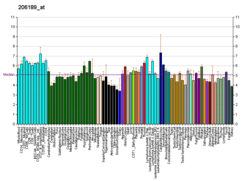UNC5C
Netrin receptor UNC5C is a protein that in humans is encoded by the UNC5C gene.[5][6][7]
This gene product belongs to the UNC-5 family of netrin receptors. Netrins are secreted proteins that direct axon extension and cell migration during neural development. They are bifunctional proteins that act as attractants for some cell types and as repellents for others, and these opposite actions are thought to be mediated by two classes of receptors. The UNC-5 family of receptors mediate the repellent response to netrin; they are transmembrane proteins containing 2 immunoglobulin (Ig)-like domains and 2 type I thrombospondin motifs in the extracellular region.[7]
References
- 1 2 3 GRCh38: Ensembl release 89: ENSG00000182168 - Ensembl, May 2017
- 1 2 3 GRCm38: Ensembl release 89: ENSMUSG00000059921 - Ensembl, May 2017
- ↑ "Human PubMed Reference:".
- ↑ "Mouse PubMed Reference:".
- ↑ Leonardo ED, Hinck L, Masu M, Keino-Masu K, Ackerman SL, Tessier-Lavigne M (May 1997). "Vertebrate homologues of C. elegans UNC-5 are candidate netrin receptors". Nature. 386 (6627): 833–8. doi:10.1038/386833a0. PMID 9126742.
- ↑ Ackerman SL, Knowles BB (Dec 1998). "Cloning and mapping of the UNC5C gene to human chromosome 4q21-q23". Genomics. 52 (2): 205–8. doi:10.1006/geno.1998.5425. PMID 9782087.
- 1 2 "Entrez Gene: UNC5C unc-5 homolog C (C. elegans)".
Further reading
- Kennedy TE (2001). "Cellular mechanisms of netrin function: long-range and short-range actions". Biochem. Cell Biol. 78 (5): 569–75. doi:10.1139/bcb-78-5-569. PMID 11103947.
- Livesey FJ (2001). "Netrins and netrin receptors". Cell. Mol. Life Sci. 56 (1–2): 62–8. doi:10.1007/s000180050006. PMID 11213262.
- Strausberg RL, Feingold EA, Grouse LH, et al. (2003). "Generation and initial analysis of more than 15,000 full-length human and mouse cDNA sequences". Proc. Natl. Acad. Sci. U.S.A. 99 (26): 16899–903. doi:10.1073/pnas.242603899. PMC 139241. PMID 12477932.
- Thiebault K, Mazelin L, Pays L, et al. (2003). "The netrin-1 receptors UNC5H are putative tumor suppressors controlling cell death commitment". Proc. Natl. Acad. Sci. U.S.A. 100 (7): 4173–8. doi:10.1073/pnas.0738063100. PMC 153067. PMID 12655055.
- Geisbrecht BV, Dowd KA, Barfield RW, et al. (2003). "Netrin binds discrete subdomains of DCC and UNC5 and mediates interactions between DCC and heparin". J. Biol. Chem. 278 (35): 32561–8. doi:10.1074/jbc.M302943200. PMID 12810718.
- Gerhard DS, Wagner L, Feingold EA, et al. (2004). "The status, quality, and expansion of the NIH full-length cDNA project: the Mammalian Gene Collection (MGC)". Genome Res. 14 (10B): 2121–7. doi:10.1101/gr.2596504. PMC 528928. PMID 15489334.
- Kruger RP, Lee J, Li W, Guan KL (2005). "Mapping netrin receptor binding reveals domains of Unc5 regulating its tyrosine phosphorylation". J. Neurosci. 24 (48): 10826–34. doi:10.1523/JNEUROSCI.3715-04.2004. PMID 15574733.
- Llambi F, Lourenço FC, Gozuacik D, et al. (2005). "The dependence receptor UNC5H2 mediates apoptosis through DAP-kinase". EMBO J. 24 (6): 1192–201. doi:10.1038/sj.emboj.7600584. PMC 556396. PMID 15729359.
- Li W, Aurandt J, Jürgensen C, et al. (2006). "FAK and Src kinases are required for netrin-induced tyrosine phosphorylation of UNC5". J. Cell Sci. 119 (Pt 1): 47–55. doi:10.1242/jcs.02697. PMC 2248276. PMID 16371650.
- Bernet A, Mazelin L, Coissieux MM, et al. (2008). "Inactivation of the UNC5C Netrin-1 receptor is associated with tumor progression in colorectal malignancies". Gastroenterology. 133 (6): 1840–8. doi:10.1053/j.gastro.2007.08.009. PMC 2211510. PMID 17967459.
This article is issued from
Wikipedia.
The text is licensed under Creative Commons - Attribution - Sharealike.
Additional terms may apply for the media files.




